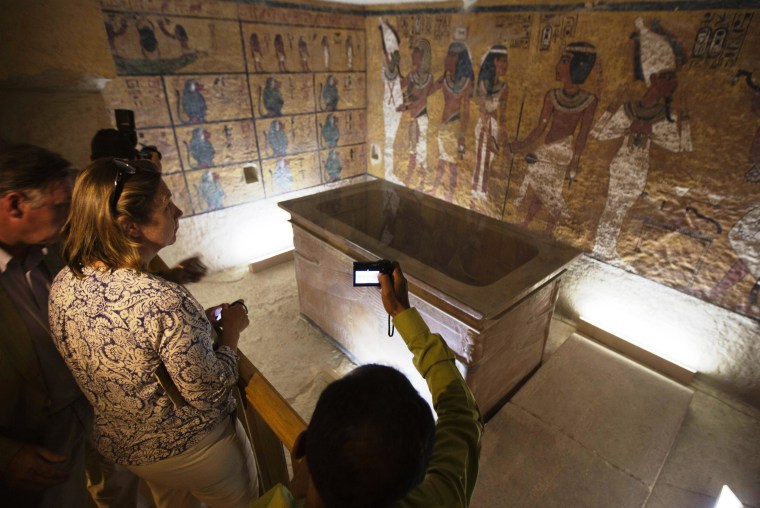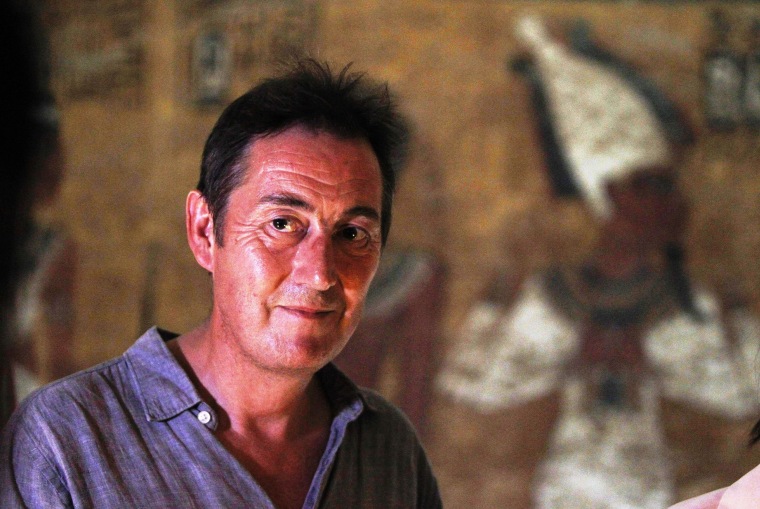CAIRO — There doesn't seem to be any curse on this version of King Tut's tomb.
Tourists this week streamed into a long-awaited replica in Egypt that was built to handle visitor demand to view the ancient boy king's ostentatious final resting place.
The exact copy, created by scanning the walls of the original in 2009, was constructed to take pressure off of the original, and includes an identical underground structure and tomb wall surface. The beautiful wall paintings that decorate the burial chamber of the original iconic tomb have taken a toll over the years from the sweat and breath of thousands of tourists.
The hope is that the replica will help preserve the original by enticing visitors with its novelty factor, low ticket prices at about $7, and complete wheelchair accessibility.
There is an added bonus: a visit to the home of Howard Carter, the archaeologist who made one of the greatest discoveries of the 20th century when he entered King Tut’s tomb in 1922 and famously described the coruscating brilliance of the interior: “… strange animals, statues, and gold -- everywhere the glint of gold."

Visitors to the replica say they were impressed with what they saw.
"It is different from what I imagined. The replica is absolutely accurate," said Johanna Sigl, an archaeologist from Munich who works with the German Archaeological Institute in Cairo. "The walls, up to the chiseling marks, are very good."
Missing is Tut's blackened mummy, which is enclosed in a protective glass case in the original.
Technology used to record the original tomb's wall paintings archived the original artwork at the highest resolution ever, with 100 million independently measured 3-D points per square meter.
Adam Lowe, a director of Factum Arte and artist who was involved in the use of the new technology, has replicated the original with the help of his team and specially designed 3-D scanners.
“Technology has now come of age and is playing a central part in preserving the past. We are using new recording systems to monitor the decay of the originals,” said Lowe. He said he has noticed that some of the original tomb paintings have dimmed even since his team took the scans in 2009.

The technology has taken a “quantum jump," said Lowe, from 2001 when a cave of the first Paleolithic painting was replicated in Spain.
"The reason the tomb looks and feels the same from a normal viewing distance is the exact recreation of surface and color," Lowe said.
The J. Paul Getty Institute is at work restoring the walls of the real Tutankhamun’s tomb, and Lowe felt it needed to be scanned before the restoration. “The whole point is that it must be done before conservation because you need data to know what is there before it is changed by conservation," Lowe said.
The reproduction may be too accurate for some.
“I thought it was extremely interesting," said tourist Elizabeth Smith, from Portsmouth, England. She said she had been to Luxor before, but wanted to visit the newly opened replica and Howard Carter’s home. "But it felt like a replica. It was too clinical."
King Tut’s new dwelling may be in good company soon. Once funding is available, Factum Arte is planning to recreate two other spectacular tombs currently closed to the general public: Nefertari’s tomb and the tomb of King Seti I. Both would also be constructed on the grounds of Carter’s museum.
Lowe’s team would create a center for scanning that could be used to train Egyptians to inventory antiquities for documentation. “Once they are trained, it could be a vital tool for them throughout the country,” said archaeologist Nigel Hetherington.
The Valley of the King’s newest arrival may breathe a bit of life into Egypt’s sputtering tourist industry while helping to preserve the ancient artistry that keeps people coming. At the official opening, Antiquities Minister Mohamed Ibrahim said he hoped the replica will stimulate tourism and lead the way to protecting other tombs.
"If this idea succeeds we will expand it to other tombs facing damage to preserve them," Ibrahim said.